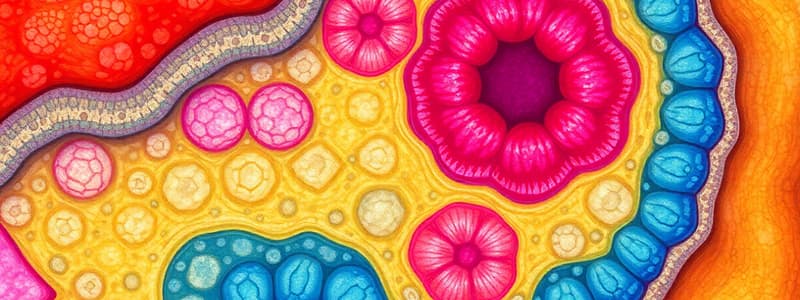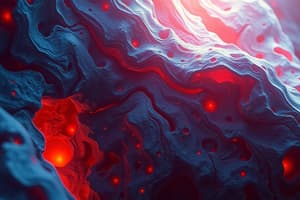Podcast
Questions and Answers
Which level of organization is directly made up of cells grouped together?
Which level of organization is directly made up of cells grouped together?
- Organ
- Organ System
- Tissue (correct)
- Molecule
What is the primary function of epithelial tissue in the body?
What is the primary function of epithelial tissue in the body?
- Cushioning organs
- Transporting oxygen
- Generating electrical signals
- Covers and protects surfaces (correct)
Which organ systems work together to facilitate respiration in the body?
Which organ systems work together to facilitate respiration in the body?
- Muscular and Skeletal
- Respiratory and Digestive
- Circulatory and Nervous
- Respiratory and Circulatory (correct)
What process describes the breakdown of food to provide nutrients to cells?
What process describes the breakdown of food to provide nutrients to cells?
Which of the following is NOT considered a necessary life function?
Which of the following is NOT considered a necessary life function?
What combination of cells forms an organ?
What combination of cells forms an organ?
In the context of tissue types, what is the main role of muscle tissue?
In the context of tissue types, what is the main role of muscle tissue?
What is the ultimate purpose of metabolism in the body?
What is the ultimate purpose of metabolism in the body?
What is the primary function of the cardiovascular system?
What is the primary function of the cardiovascular system?
Which organ systems are primarily responsible for the intake of oxygen and nutrients?
Which organ systems are primarily responsible for the intake of oxygen and nutrients?
Which of the following is NOT a function of the muscular system?
Which of the following is NOT a function of the muscular system?
What is a primary waste product eliminated by the respiratory system?
What is a primary waste product eliminated by the respiratory system?
Which of the following components does the integumentary system include?
Which of the following components does the integumentary system include?
Which organ systems work together to eliminate metabolic wastes?
Which organ systems work together to eliminate metabolic wastes?
What kind of balance does the urinary system regulate?
What kind of balance does the urinary system regulate?
Which of the following is a key characteristic of the endocrine system?
Which of the following is a key characteristic of the endocrine system?
What is the primary purpose of the lymphatic system?
What is the primary purpose of the lymphatic system?
The skeletal system is essential for what primary function?
The skeletal system is essential for what primary function?
Flashcards
Anatomy
Anatomy
The study of the structure of the body and the relationships of its various parts.
Physiology
Physiology
The study of the functions of the body's parts, including specific organ systems.
Cell
Cell
The smallest unit of life, capable of carrying out all life processes.
Tissue
Tissue
Signup and view all the flashcards
Organ
Organ
Signup and view all the flashcards
Organ System
Organ System
Signup and view all the flashcards
Respiration
Respiration
Signup and view all the flashcards
Digestion
Digestion
Signup and view all the flashcards
Cellular Respiration
Cellular Respiration
Signup and view all the flashcards
ATP (Adenosine Triphosphate)
ATP (Adenosine Triphosphate)
Signup and view all the flashcards
Integumentary System
Integumentary System
Signup and view all the flashcards
Skeletal System
Skeletal System
Signup and view all the flashcards
Muscular System
Muscular System
Signup and view all the flashcards
Cardiovascular System
Cardiovascular System
Signup and view all the flashcards
Lymphatic System
Lymphatic System
Signup and view all the flashcards
Respiratory System
Respiratory System
Signup and view all the flashcards
Digestive System
Digestive System
Signup and view all the flashcards
Urinary System
Urinary System
Signup and view all the flashcards
Study Notes
Human Body Organization
- Cells are organized into tissues.
- Tissues are organized into organs.
- Organs are organized into systems.
- Systems work together to form an organism.
Necessary Life Functions
- Respiration: Taking in oxygen and releasing carbon dioxide.
- Digestion: Breaking down food into usable nutrients.
- Excretion: Removing waste products from the body.
- Movement: Locomotion, propulsion, and contractility.
- Responsiveness: Sensing and responding to changes in the environment.
- Metabolism: All chemical reactions in the body.
- Reproduction: Cellular and organismal reproduction.
- Growth: Increase in size of body parts or the entire organism.
Organ Systems
- Integumentary: Forms external covering, protects, and synthesizes vitamin D.
- Skeletal: Supports and protects organs and forms framework for muscles.
- Muscular: Movement and posture, produces heat.
- Cardiovascular: Transports nutrients and oxygen via the heart and blood vessels.
- Lymphatic: Removes fluid from tissues and returns to blood, houses immunity cells, disposes of debris.
- Respiratory: Takes in oxygen and removes carbon dioxide.
- Digestive: Breaks down food into absorbable units.
- Endocrine: Controls long-term processes like growth and fluid balance.
- Urinary: Removes metabolic wastes.
- Nervous: Fast-acting control system, responds to stimuli.
- Reproductive: Involved in reproduction.
Cellular Respiration and Energy
- Glucose and oxygen are used to produce energy in mitochondria.
- Carbon dioxide and water are waste products.
- ATP (adenosine triphosphate) stores energy for cellular activities.
- Body systems work together to provide food, oxygen, and remove waste.
Studying That Suits You
Use AI to generate personalized quizzes and flashcards to suit your learning preferences.




